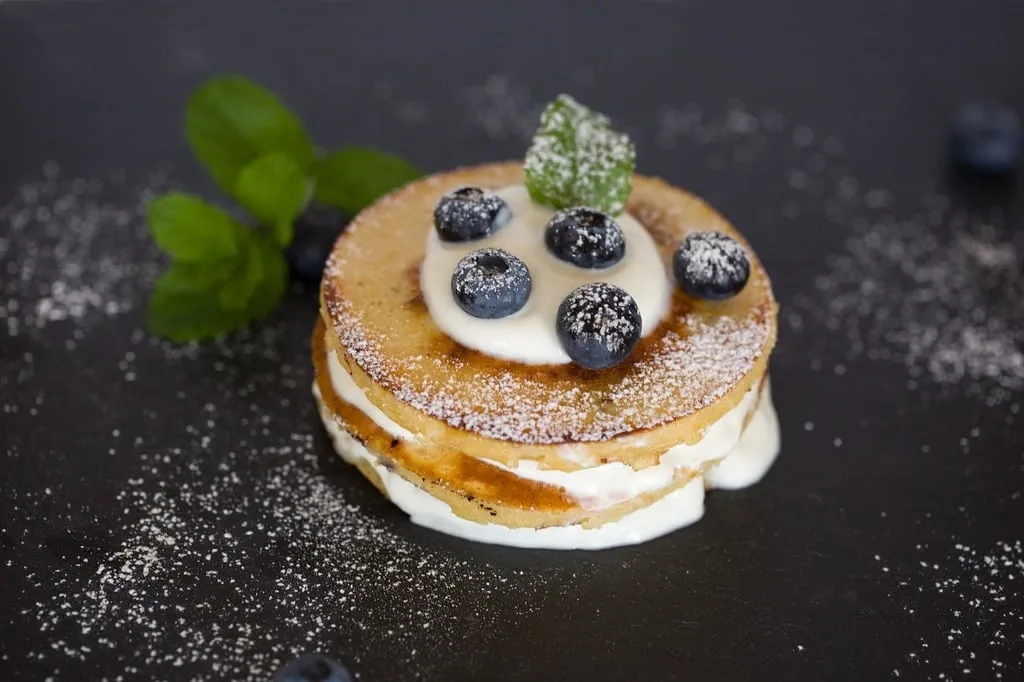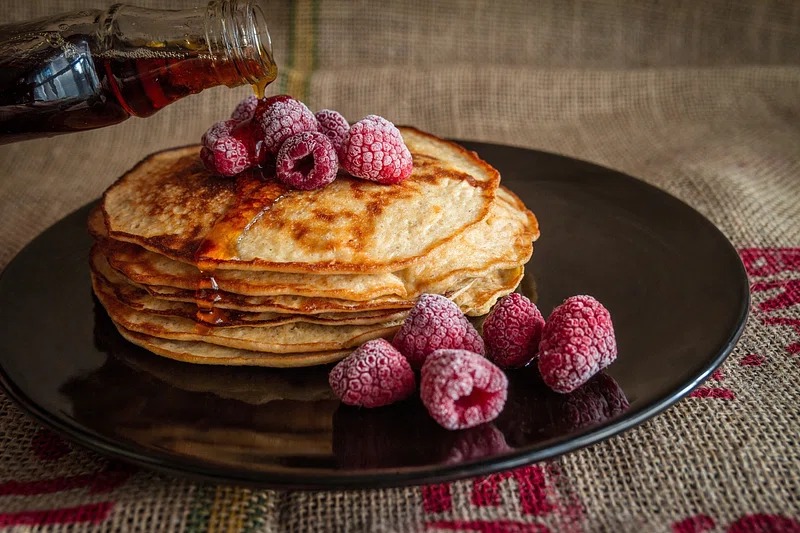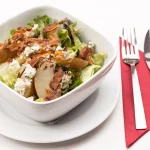The Best Fluffy Pancakes recipe you will fall in love with. Full of tips and tricks to help you make the best pancakes.
There’s nothing quite like a stack of golden, fluffy pancakes to start your morning right. Whether you’re making breakfast for the family or treating yourself to a weekend indulgence, mastering the art of pancakes is a must. But what makes the perfect pancake? It’s all about the right ingredients, proper mixing techniques, and cooking at the ideal temperature.
In this guide, we’ll uncover the secrets to making the ultimate pancake breakfast—soft, airy, and perfectly golden. From the best batter tips to expert cooking techniques and delicious toppings, you’ll have everything you need to create a breakfast worth waking up for. Let’s get started!
The Key Ingredients for Perfect Pancakes
The secret to making golden, fluffy pancakes starts with selecting the right ingredients. While pancakes may seem simple, each ingredient plays a crucial role in achieving the perfect texture, flavor, and rise. Let’s break down the essential components that make your pancakes light, airy, and delicious.

1. Buttermilk vs. Regular Milk: Which One Makes Pancakes Fluffier?
One of the biggest factors in achieving soft, fluffy pancakes is using buttermilk instead of regular milk. Buttermilk contains natural acidity that reacts with baking soda, helping to create bubbles in the batter. This reaction results in pancakes that are tender and rise beautifully. If you don’t have buttermilk on hand, you can make a substitute by adding a tablespoon of vinegar or lemon juice to a cup of milk and letting it sit for a few minutes.
2. The Role of Baking Powder and Baking Soda: How They Help with the Rise
Leavening agents like baking powder and baking soda are responsible for making pancakes rise. Baking powder is a double-acting leavening agent, meaning it starts working as soon as it’s mixed with wet ingredients and continues to create air pockets while cooking. Baking soda, on the other hand, needs an acid (like buttermilk) to activate. Using both in the right proportions ensures your pancakes turn out fluffy rather than dense.
3. Vanilla Extract and Butter: Adding Flavor and Richness
While leavening agents affect texture, ingredients like vanilla extract and butter enhance flavor. A splash of vanilla extract adds a warm, slightly sweet aroma to your pancakes, making them taste richer. Melted butter, when added to the batter, provides moisture and a tender crumb. For an even better taste, consider browning the butter slightly before adding it, which gives the pancakes a deeper, nutty flavor.
4. The Importance of Eggs: Binding and Structure
Eggs serve multiple purposes in pancake batter. They provide structure, help bind the ingredients together, and contribute to the overall texture. The proteins in eggs create stability, while the yolks add richness. If you prefer extra fluffy pancakes, try separating the eggs, whipping the egg whites to soft peaks, and gently folding them into the batter before cooking. This method creates a lighter texture with an airy feel.
5. Choosing the Right Flour: All-Purpose vs. Whole Wheat
Flour is the foundation of any pancake batter, but choosing the right type can make a difference. All-purpose flour is the most common choice because it provides a balanced texture—soft yet sturdy enough to hold up to toppings. Whole wheat flour adds more fiber and a nutty flavor but can make pancakes denser. To keep them fluffy while incorporating whole wheat, try using a mix of both flours or opt for cake flour for a lighter texture.
By understanding how each ingredient affects the final result, you can tweak your pancake recipe to match your taste and texture preferences. The right balance of leavening, fat, and flavor will ensure your pancakes turn out golden, fluffy, and irresistibly delicious every time!
How to Make the Best Pancake Batter
The secret to golden, fluffy pancakes isn’t just in the ingredients—it’s also in how you mix and handle the batter. A well-made batter ensures your pancakes rise properly, have the right texture, and cook evenly. Follow these key steps to create the perfect pancake batter every time, and try out different pancake variations to suit your taste.

1. Classic Buttermilk Pancakes
These pancakes are soft, fluffy, and slightly tangy thanks to the buttermilk. They pair perfectly with butter and warm maple syrup.
Ingredients:
- 2 cups all-purpose flour
- 2 tbsp granulated sugar
- 2 tsp baking powder
- ½ tsp baking soda
- ½ tsp salt
- 2 cups buttermilk
- 2 large eggs
- ¼ cup melted butter
- 1 tsp vanilla extract
Instructions:
- In a large bowl, whisk together the flour, sugar, baking powder, baking soda, and salt.
- In a separate bowl, whisk the buttermilk, eggs, melted butter, and vanilla.
- Gently fold the wet ingredients into the dry ingredients. Do not overmix—lumps are okay.
- Let the batter rest for 5–10 minutes.
- Heat a lightly greased pan over medium heat. Pour ¼ cup of batter per pancake.
- Cook until bubbles appear on the surface, then flip and cook until golden brown.
- Serve warm with butter and maple syrup.
2. Fluffy Japanese Soufflé Pancakes
These thick and airy pancakes are made by whipping egg whites to create a soufflé-like texture.
Ingredients:
- ½ cup all-purpose flour
- 1 tbsp sugar
- ½ tsp baking powder
- 2 large eggs, separated
- 2 tbsp milk
- ½ tsp vanilla extract
- ¼ tsp cream of tartar
- 1 tbsp vegetable oil
Instructions:
- In a bowl, whisk the flour, sugar, and baking powder.
- In another bowl, mix egg yolks, milk, vanilla, and oil. Combine with dry ingredients.
- In a clean bowl, beat egg whites and cream of tartar until stiff peaks form.
- Gently fold egg whites into the batter. Do not overmix.
- Heat a pan over low heat. Grease it lightly and spoon batter into tall stacks.
- Cover and cook for 4–5 minutes. Flip carefully and cook for another 4 minutes.
- Serve with powdered sugar, whipped cream, and fresh fruit.
3. Healthy Whole Wheat Banana Pancakes
These naturally sweet pancakes are made with whole wheat flour and bananas for a nutritious twist.
Ingredients:
- 1 cup whole wheat flour
- ½ cup all-purpose flour
- 1 tsp baking powder
- ½ tsp baking soda
- ¼ tsp salt
- 1 ripe banana, mashed
- 1 cup milk (or almond milk)
- 1 egg
- 1 tbsp honey or maple syrup
- 1 tsp vanilla extract
- 2 tbsp melted coconut oil
Instructions:
- In a large bowl, mix whole wheat flour, all-purpose flour, baking powder, baking soda, and salt.
- In another bowl, mash the banana and mix in milk, egg, honey, vanilla, and melted coconut oil.
- Combine wet and dry ingredients. Stir gently—don’t overmix.
- Let the batter sit for 10 minutes for better texture.
- Heat a pan over medium heat, grease lightly, and cook pancakes for 2–3 minutes per side.
- Serve with extra banana slices and a drizzle of honey.
4. Cinnamon Sugar Churro Pancakes
A delicious twist on classic pancakes with a crispy cinnamon sugar coating.
Ingredients:
- 1 ½ cups all-purpose flour
- 1 tbsp sugar
- 1 tsp baking powder
- ½ tsp baking soda
- ½ tsp salt
- 1 tsp cinnamon
- 1 ¼ cups milk
- 1 egg
- 1 tsp vanilla extract
- 2 tbsp melted butter
For the topping: - 2 tbsp melted butter
- ¼ cup granulated sugar
- 1 tsp cinnamon
Instructions:
- Whisk together the flour, sugar, baking powder, baking soda, salt, and cinnamon.
- In another bowl, mix the milk, egg, vanilla, and melted butter.
- Gently combine the wet and dry ingredients without overmixing.
- Let the batter rest for 5 minutes.
- Heat a pan over medium heat and cook pancakes until golden.
- Brush each pancake with melted butter and sprinkle with cinnamon sugar.
- Serve with a drizzle of caramel or chocolate sauce.
5. Decadent Chocolate Chip Pancakes
These pancakes are loaded with gooey chocolate chips, making them the perfect treat for breakfast lovers.
Ingredients:
- 2 cups all-purpose flour
- 2 tbsp sugar
- 2 tsp baking powder
- ½ tsp baking soda
- ¼ tsp salt
- 1 ½ cups milk
- 1 large egg
- 1 tsp vanilla extract
- ¼ cup melted butter
- ½ cup chocolate chips
Instructions:
- Whisk together flour, sugar, baking powder, baking soda, and salt.
- In another bowl, mix milk, egg, vanilla, and melted butter.
- Combine wet and dry ingredients, stirring gently. Fold in chocolate chips.
- Let the batter rest for 5 minutes.
- Heat a pan over medium heat and cook pancakes until bubbles appear, then flip.
- Serve with whipped cream, chocolate sauce, or a dusting of powdered sugar.
Cooking Pancakes to Golden Perfection
Making the perfect pancake isn’t just about the batter—it’s also about how you cook it. The right pan, temperature, and flipping technique all play a crucial role in achieving golden, fluffy pancakes with a slightly crisp edge. Follow these steps to ensure your pancakes turn out just right every time.
Recommended Ninja NeverStick Ceramic Pro 14-Piece Cookware Set, Non-Stick Pots & Pans Set with Glass Lids, Ceramic Coated, Stainless Steel, Stove to Oven Safe, All Stovetops & Induction Compatible, Blue CW39014MM Check Out

1. Choosing the Best Skillet or Griddle: Non-Stick vs. Cast Iron
The type of pan you use affects how evenly your pancakes cook and how easily they release from the surface. Here are the best options:
- Non-Stick Skillet: A great beginner-friendly choice, as it requires little oil and prevents sticking. However, non-stick pans can wear out over time.
- Cast Iron Skillet: Retains heat well and gives pancakes a beautiful golden crust. Just make sure it’s well-seasoned to prevent sticking.
- Electric Griddle: Ideal for cooking multiple pancakes at once and maintaining a consistent temperature.
For the best results, preheat your pan or griddle before adding the batter to ensure even cooking.
2. Ideal Cooking Temperature: Preventing Undercooked or Burnt Pancakes
Cooking pancakes at the right temperature is key to getting a golden-brown exterior without burning them or leaving the inside raw.
- Set your stove to medium-low or heat your griddle to 325°F (163°C).
- If the pan is too hot, the outside will burn before the inside is fully cooked.
- If the pan is too cool, the pancakes will take too long to cook, becoming dry and dense.
A simple test: Drop a few water droplets on the pan. If they sizzle and evaporate quickly, it’s ready. If they sit there without bubbling, the pan needs more heat.
3. How to Grease the Pan for Even Cooking
Adding the right amount of fat to your pan can make all the difference in how your pancakes cook and taste.
- Butter: Adds a rich, slightly caramelized flavor but can burn quickly if the heat is too high. Wipe excess butter between batches to prevent burning.
- Oil: A neutral oil like canola or vegetable oil has a higher smoke point and won’t burn as quickly as butter.
- Combination: Try using a little butter for flavor and oil for cooking stability.
For an even coating, use a paper towel or silicone brush to lightly grease the pan before pouring the batter. Too much oil or butter can cause uneven browning.
4. When to Flip: Watching for Bubbles and Edges
Timing is everything when flipping pancakes. Flipping too early can cause them to break apart, while flipping too late can result in overcooking.
Look for these three signs before flipping:
- Bubbles form on the surface. The batter should have small, consistent bubbles across the pancake.
- Edges start to look dry. The sides should set and lose their glossy appearance.
- The bottom is golden-brown. Use a spatula to gently lift the edge and check the color.
Pro tip: Flip only once! Repeated flipping can deflate the pancake and make it tough.
5. Cooking the Second Side and Avoiding Soggy Pancakes
After flipping, the second side usually takes less time to cook—about half the time of the first side.
- Reduce the heat slightly if the pancakes are browning too fast.
- Avoid pressing down on the pancake with the spatula, as this can make it dense instead of fluffy.
- Let the pancakes cook undisturbed for about 1–2 minutes until the bottom is golden and the inside is fully cooked.
Once done, transfer the pancakes to a warm plate or baking sheet in a 200°F (93°C) oven to keep them warm while you cook the rest.
Delicious Toppings and Syrups to Try
Once you’ve mastered the art of making golden, fluffy pancakes, it’s time to take them to the next level with delicious toppings and syrups. The right toppings can elevate your pancakes from simple breakfast fare to a gourmet treat. Whether you prefer classic choices like maple syrup and butter or want to get creative with fruits, nuts, and unique drizzles, there’s a perfect pancake topping for everyone.

1. Classic Toppings: The Tried-and-True Favorites
These timeless toppings never fail to complement a warm stack of pancakes.
- Pure Maple Syrup: A breakfast staple, real maple syrup adds rich, caramelized sweetness. Opt for Grade A Dark for a more intense flavor.
- Melted Butter: Nothing beats the taste of warm, melted butter slowly soaking into each pancake. For extra flavor, try whipped or browned butter.
- Powdered Sugar: A light dusting of powdered sugar adds a delicate sweetness and makes your pancakes look picture-perfect.
- Whipped Cream: Light, airy, and slightly sweet, whipped cream pairs well with fresh fruit and chocolate chips.
Pro Tip: Warm your syrup slightly before pouring it over pancakes for an extra cozy touch!
2. Fresh Fruits: A Natural and Refreshing Twist
Adding fresh fruit brings a burst of flavor and natural sweetness while balancing the richness of the pancakes.
- Sliced Bananas: Soft and creamy, bananas pair wonderfully with peanut butter, chocolate, or caramel.
- Berries (Strawberries, Blueberries, Raspberries): Fresh or macerated berries provide a juicy, slightly tart contrast to sweet pancakes.
- Diced Apples or Pears: Sauté them with cinnamon and a touch of butter for a warm, spiced topping.
- Coconut Flakes: Toasted coconut adds a tropical flavor and slight crunch.
Tip: If using frozen berries, toss them in a little sugar and let them thaw slightly before adding them on top.
3. Nutty and Crunchy Additions for Extra Texture
Adding nuts and seeds provides a delightful crunch and enhances the overall flavor.
- Chopped Pecans or Walnuts: Toasting them before sprinkling adds depth and brings out their natural oils.
- Slivered Almonds: A light and slightly sweet nut that pairs well with vanilla or citrus-flavored pancakes.
- Granola: A fantastic way to add crunch and a hint of cinnamon, honey, or dried fruit.
- Peanut Butter or Almond Butter: Drizzle it over your pancakes for a nutty, protein-packed boost.
Tip: Mix chopped nuts into the batter for extra crunch inside the pancakes!
4. Decadent and Sweet Drizzles
For those who love indulgent flavors, these syrups and sauces will take your pancakes to dessert level.
- Chocolate Syrup: A drizzle of warm chocolate sauce or Nutella makes for an irresistible treat.
- Caramel Sauce: Whether it’s classic caramel or salted caramel, this topping pairs beautifully with bananas and pecans.
- Honey or Agave Syrup: A great alternative to maple syrup, honey provides natural sweetness with floral notes.
- Fruit Compote: Simmer your favorite berries or stone fruits with a little sugar and lemon juice to create a homemade fruit sauce.
Tip: For extra richness, add a sprinkle of sea salt over chocolate or caramel toppings!
5. Unique and Gourmet Toppings to Try
Looking for something out of the ordinary? Try these creative toppings to impress your guests or simply treat yourself.
- Mascarpone or Cream Cheese Drizzle: Mix with honey and vanilla for a creamy, tangy topping.
- Lemon Curd: The bright citrusy flavor contrasts beautifully with the soft, buttery pancakes.
- Crushed Cookies or Graham Crackers: Sprinkle crushed Oreos, Biscoff, or graham crackers for a fun twist.
- Matcha Powder or Cocoa Powder: Lightly dust the pancakes for an elegant, sophisticated flavor.
Tip: Try a savory-sweet combo by adding crispy bacon crumbles with a drizzle of maple syrup!
Common Pancake Mistakes and How to Fix Them
Even experienced home cooks can make mistakes when preparing pancakes. From dense, rubbery textures to burnt exteriors with raw centers, small missteps can make a big difference in how your pancakes turn out. Here’s a guide to the most common pancake mistakes and simple fixes to help you achieve perfect, fluffy pancakes every time.

Overmixing the Batter: Why Less Is More
The Mistake: You mix the batter until it’s completely smooth, thinking it will result in evenly cooked pancakes.
The Problem: Overmixing develops the gluten in the flour, making pancakes tough and dense instead of light and fluffy.
The Fix:
- Stir the batter gently and briefly until the dry ingredients are just combined with the wet ingredients.
- Some lumps are okay; they will dissolve as the pancakes cook.
- Use a whisk or spatula instead of an electric mixer to avoid overworking the batter.
Pro Tip: Let the batter rest for 5–10 minutes before cooking to allow the flour to absorb the liquid, leading to fluffier pancakes.
Using the Wrong Heat Setting
The Mistake: Cooking pancakes on high heat to speed up the process.
The Problem: High heat causes pancakes to brown too quickly on the outside while staying raw in the middle. Low heat can make them dry and rubbery.
The Fix:
- Set your burner to medium-low to medium heat or preheat your griddle to 325°F (163°C).
- Allow the pan or griddle to heat evenly before pouring the batter.
- If pancakes are browning too fast, lower the heat slightly. If they take too long to cook, increase the heat slightly.
Test: Drop a few water droplets on the pan—if they sizzle and evaporate quickly, the pan is ready.
Using a Cold or Unevenly Heated Pan
The Mistake: Pouring batter onto a pan that hasn’t been preheated properly.
The Problem: Pancakes cook unevenly, with some spots burning while others stay pale.
The Fix:
- Preheat the pan or griddle for at least 2–3 minutes before adding batter.
- If using a stovetop, rotate the pan occasionally to distribute heat evenly.
- An electric griddle is great for maintaining consistent heat.
Pro Tip: Use a cast iron or non-stick pan for even cooking and easier flipping.
Flipping Pancakes Too Early or Too Often
The Mistake: Flipping pancakes as soon as bubbles appear or flipping them multiple times.
The Problem: Flipping too early makes pancakes fall apart. Flipping too often deflates them, making them dense and dry.
The Fix:
- Wait for bubbles to appear across the surface and for the edges to look dry before flipping.
- Flip the pancake only once using a wide spatula for support.
- Cook the second side for half the time of the first side.
Pro Tip: If pancakes break apart while flipping, they’re too thin—add a little more flour to the batter next time.
Not Using the Right Amount of Grease
The Mistake: Adding too much or too little butter or oil to the pan.
The Problem: Too much butter or oil makes pancakes greasy and unevenly cooked. Too little fat causes sticking and uneven browning.
The Fix:
- Lightly grease the pan using a paper towel or silicone brush.
- If using butter, wipe off excess between batches to prevent burning.
- If pancakes stick, try a non-stick skillet or griddle.
Pro Tip: For a crispy edge, use a small amount of butter; for a lighter pancake, opt for a neutral oil like vegetable or canola oil.
Measuring Ingredients Incorrectly
The Mistake: Scooping flour directly from the bag or eyeballing measurements.
The Problem: Too much flour makes pancakes dense and dry, while too much liquid makes them flat and runny.
The Fix:
- Use the spoon and level method: Spoon flour into a measuring cup, then level it with a knife.
- For best results, use a kitchen scale to measure ingredients accurately.
- Double-check that your baking powder is fresh (it loses effectiveness over time).
Pro Tip: If your batter is too thick, add a splash of milk. If it’s too runny, add a tablespoon of flour at a time.
Not Keeping Pancakes Warm
The Mistake: Cooking pancakes in batches but letting them cool on a plate.
The Problem: Pancakes become cold and soggy before serving.
The Fix:
- Place cooked pancakes on a baking sheet in a 200°F (93°C) oven to keep them warm.
- Don’t stack pancakes immediately—spread them out slightly to prevent steaming.
- If reheating, use an oven or toaster instead of the microwave to maintain texture.
Pro Tip: Freeze extra pancakes in a single layer, then reheat them in a toaster for a quick breakfast.






[…] Pancake bites are a great alternative to traditional pancakes, offering the same fluffy texture in a convenient, poppable size. They can be made with different mix-ins, such as blueberries, chocolate chips, or nuts. […]
[…] Pancakes are a breakfast staple, and the Blackstone griddle turns them into something truly special. The large space lets you cook several at once, perfect for feeding a group. Use a ladle or squeeze bottle for even pouring, and watch them rise into fluffy stacks of golden deliciousness. Add blueberries, chocolate chips, or bananas for a fun twist. Serve with butter and warm maple syrup right off the griddle for that diner-style experience. […]